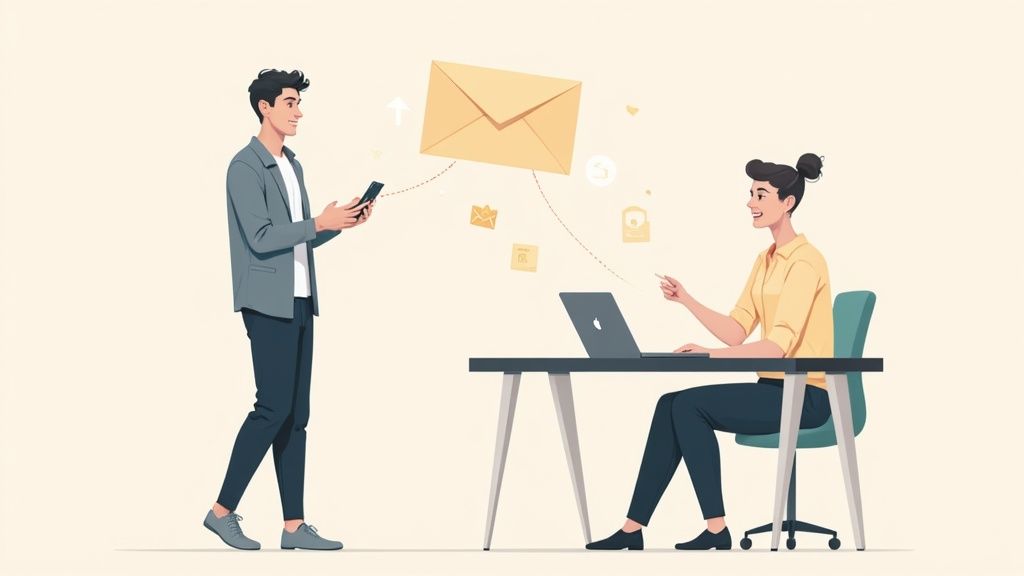
How to Follow Up with a Recruiter & Get Noticed
Following up with a recruiter is a smart, strategic move that keeps your name at the top of their list. A quick, professional message within 24 hours of an interview, followed by a polite check-in after about a week, does more than just show good manners. It reinforces your interest and proves you’re a proactive communicator, turning a simple courtesy into a real competitive advantage.
Why Your Follow-Up Strategy Is More Than Just Politeness
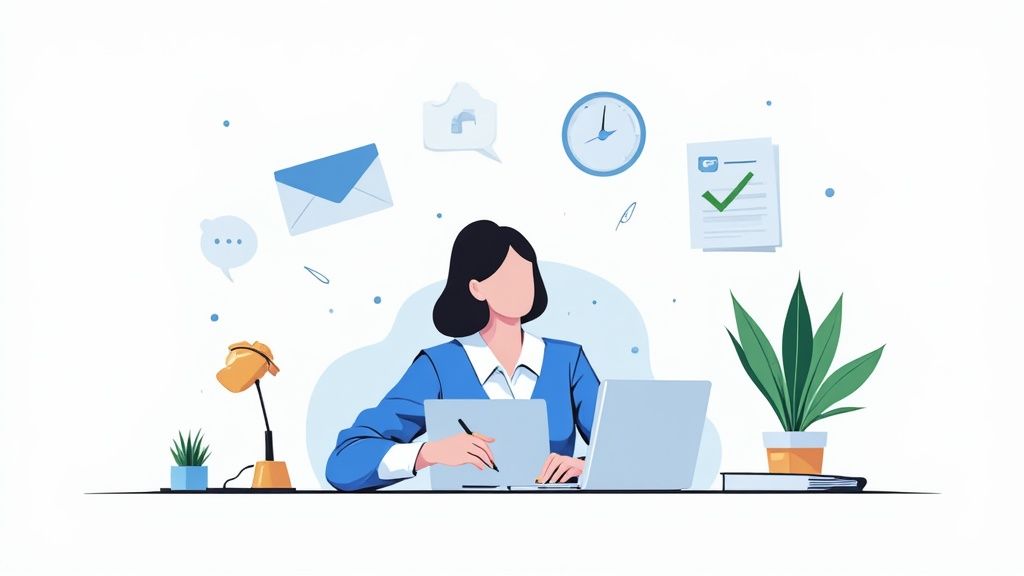
Staring at your inbox, wondering if you should hit send? Let’s be clear: following up isn’t just a courtesy, it’s a critical part of your job search strategy, especially in a crowded market. Recruiters are juggling more candidates than ever, and hiring cycles are getting longer.
The recruiting world has gotten incredibly intense. Recent data shows that recruiters are now conducting 42% more interviews per hire than they did just a few years ago, jumping from an average of 14 to 20. On top of that, the average time to fill a role has stretched by 24%, from 33 days to 41. You can dig into these trends in the full recruiting benchmarks report from Gem.
In this kind of environment, a thoughtful follow-up is your best tool for staying on the radar.
From A Chore To An Opportunity
When you stop seeing the follow-up as a dreaded task and start treating it as a strategic opportunity, everything changes. A simple, well-timed message can accomplish a few key goals all at once.
- It demonstrates professionalism. A follow-up shows you’re organized, attentive, and truly serious about the role.
- It reiterates your enthusiasm. This is your chance to express your genuine interest in the company and position one last time.
- It helps you stand out. You’d be surprised how many applicants don’t bother. Taking this extra step immediately sets you apart from the pack.
A great follow-up isn’t about nagging, “Have you made a decision yet?” It’s about showing you’re still engaged, thoughtful, and the kind of proactive person they’d want on their team.
Ultimately, knowing how to follow up effectively is about making the recruiter’s job easier. By providing a clear, concise, and professional touchpoint, you prove you’re the organized and communicative candidate they’ve been looking for.
Getting the Timing and Frequency Right
Knowing when and how often to follow up with a recruiter feels like walking a tightrope. Come on too strong, and you seem desperate. Wait too long, and you risk fading into the background. The goal is to be politely persistent, keeping your name top-of-mind without becoming a nuisance.
Your first move is non-negotiable: send a thank-you email within 24 hours of any interview or substantive conversation. It’s a simple gesture, but it shows you’re engaged, professional, and genuinely appreciate their time. After that, the timeline gets a bit more flexible.
The Ideal Follow-Up Cadence
A good rule of thumb is to give them about five business days after an interview before you send a gentle nudge. Recruiters are juggling multiple roles and candidates, so a little patience goes a long way.
If you still haven’t heard anything after that first check-in, one final, polite follow-up after another week (roughly 10 business days post-interview) is perfectly acceptable. Sticking to a schedule like this shows you’re organized and respectful of their process. When you’re applying to several jobs at once, keeping all these dates straight can be a headache, which is why a solid job application tracker is an absolute lifesaver.
This visual gives you a great at-a-glance guide for your outreach timeline.
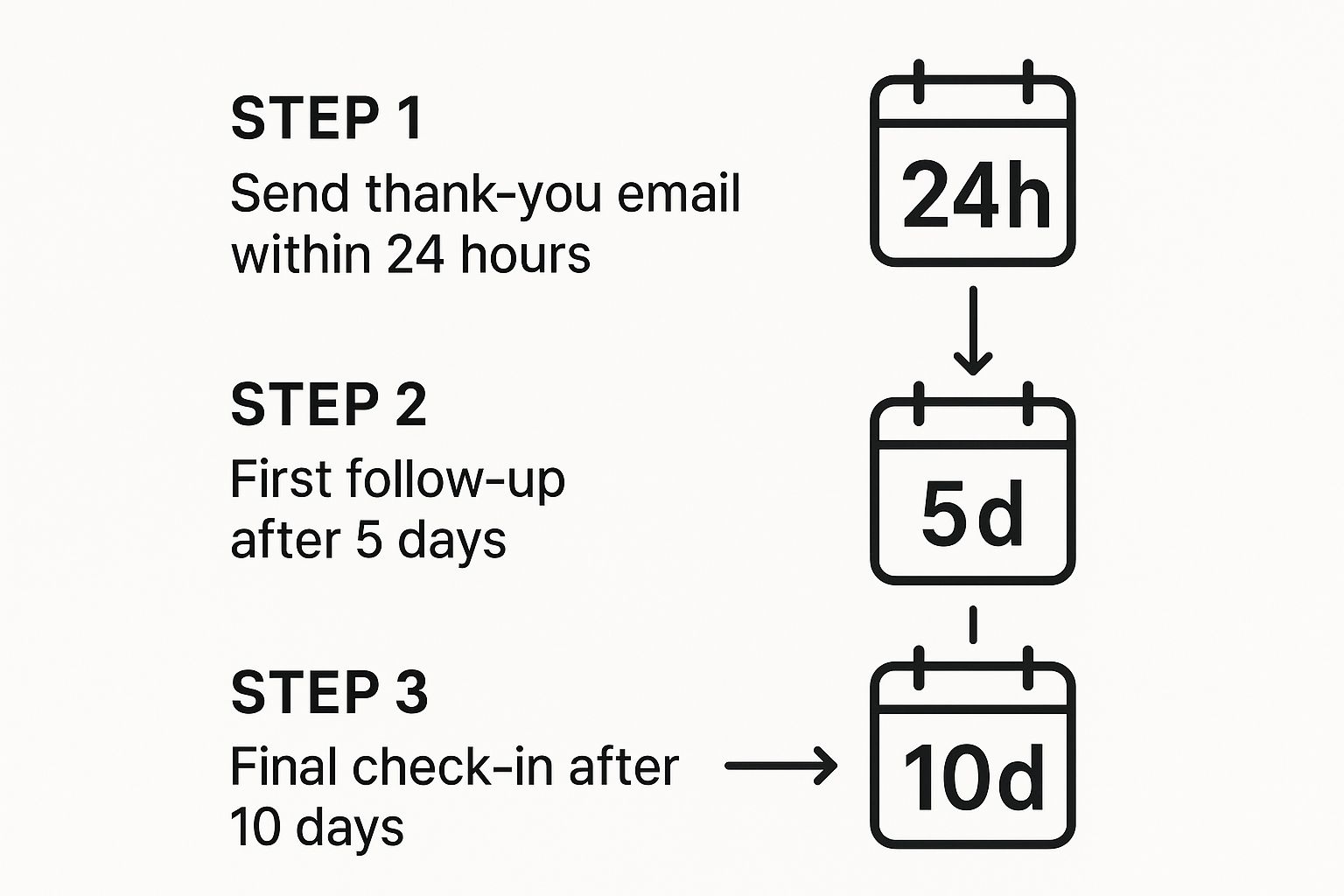
As you can see, it’s a simple three-touch process: the immediate thank-you, a patient first check-in, and a final, courteous nudge. This keeps you on their radar without overwhelming them.
While this cadence is a great starting point, always listen for cues from the recruiter.
Expert Tip: Don’t just follow a generic rule like ‘wait one week.’ Use the timeline the recruiter gave you as your primary guide. If they said you’d hear back by Friday, wait until Monday afternoon before sending a polite check-in. This shows you were listening and respect their process.
Recruiter Follow-Up Timing Cheat Sheet
To make things even easier, here’s a quick cheat sheet for when to follow up at each stage of the hiring game. Think of it as your roadmap to staying visible and professional.
| Hiring Stage | When to Follow Up | Key Objective |
|---|---|---|
| After Application | 1-2 weeks after the closing date (if listed) | Confirm receipt and express continued interest. |
| After Phone Screen | Within 24 hours (thank you), then 5 business days later | Thank them and reiterate your qualifications. |
| After First Interview | Within 24 hours (thank you), then 5-7 business days later | Express gratitude and briefly add a new point of value. |
| After Final Interview | Within 24 hours (thank you), then follow the timeline they gave you | Reinforce your fit for the role and your excitement. |
| After a “No” | Within 24 hours | Thank them for the opportunity and ask to stay connected. |
This table helps you tailor your approach based on where you are in the conversation, ensuring every message you send is timely and relevant.
Writing a Follow-Up Email That Actually Gets Read
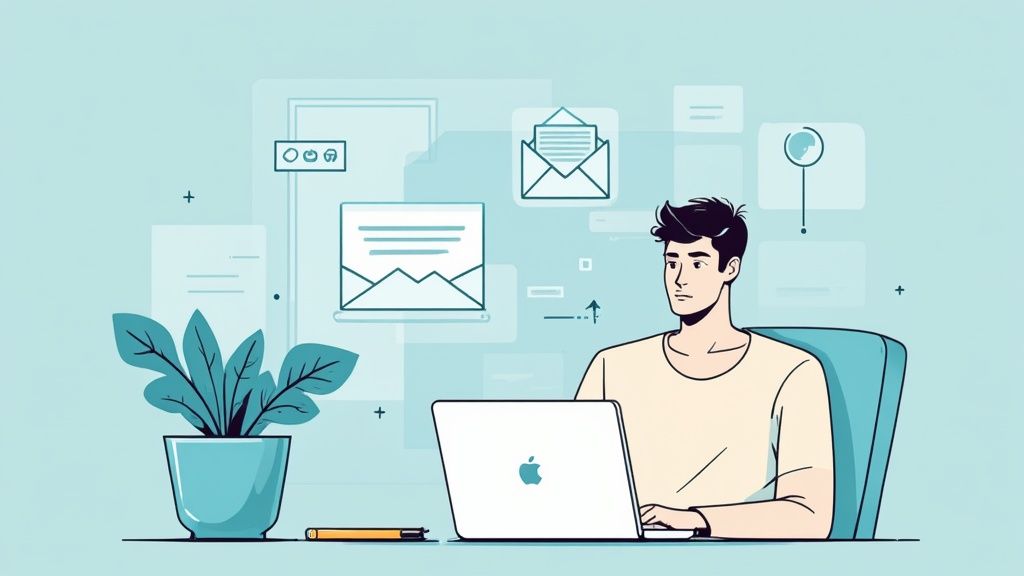
Let’s be honest: a recruiter’s inbox is a crowded place. To stand out, your follow-up email can’t just be a generic, forgettable template. It has to be sharp, professional, and genuinely helpful, proving you’re the thoughtful, organized candidate they’re looking for.
It all starts with the subject line. This is your first impression—and your only chance to get the email opened. Vague phrases like “Checking In” or “Follow-Up” are the digital equivalent of mumbling; they’re easy to ignore and even easier to delete.
Your goal is to make the recruiter’s job easier. A solid subject line gives them all the context they need at a glance.
Try a simple, searchable formula like this:
- Follow-Up: [Job Title] Interview - [Your Full Name]
Something like, “Follow-Up: Senior Marketing Manager Interview - Jane Doe” works perfectly. It’s clear, professional, and immediately tells them who you are and why you’re emailing.
The Anatomy of a Powerful Message
Once they’ve opened your email, you have about 15 seconds to make your point. Recruiters scan, they don’t read novels. Keep it short and punchy—three quick paragraphs is the sweet spot.
Start by genuinely thanking them for their time. But don’t stop there. Mention something specific from your conversation that resonated with you. It could be a company value they highlighted or a particular challenge the team is facing. This small detail shows you were engaged and actually listening.
Next, you need to add a little more value. This is where you gently remind them why you’re a great fit. Briefly connect a skill or a past success to something they mentioned. For example, if they talked about needing someone to improve social media engagement, you could add a sentence like, “I’ve been thinking more about your goal to boost engagement, and it reminded me of the campaign I led at [Previous Company] where we increased our reach by 40%.”
A great follow-up subtly continues the interview. It’s one last chance to reinforce why you’re the right fit, offer a new piece of relevant information, or demonstrate your thoughtful approach to the role.
Finally, wrap it up cleanly. End with a simple, professional closing. Reiterate your enthusiasm for the opportunity and mention you’re looking forward to hearing about the next steps.
Examples for Different Scenarios
The timing and tone of your follow-up will shift depending on where you are in the process. You always want to come across as helpful, not desperate.
-
The Post-Interview Thank You (Within 24 Hours): This one is non-negotiable. Send it promptly to show your enthusiasm. This is where you’ll reference a specific part of your conversation to make it memorable.
-
The Gentle Nudge (After 5-7 Business Days): If the timeline they gave you has come and gone, a polite check-in is perfectly fine. Keep this one extra short—a simple, professional note asking if there are any updates on their end is all you need.
-
The Final Check-In (After 10+ Days): Still hearing crickets? One last, brief email can provide closure. Reiterate your interest but signal that you understand they’re busy and will wait for their update. This keeps the door open without being pushy.
Getting the feel for each type of message is a game-changer. For a deeper dive with more specific templates, you can check out our complete guide on crafting the perfect application follow-up email. Mastering this skill ensures every time you hit “send,” you’re making a positive impression.
Navigating Tricky Follow-Up Scenarios
The job hunt rarely goes exactly as planned. Knowing how to handle the awkward silences and unexpected turns is a skill that separates good candidates from great ones. How you follow up can easily turn a tricky situation into an opportunity to show your professionalism.
Let’s talk about the most common scenario: radio silence. The recruiter mentioned you’d hear back by Tuesday, it’s now Thursday, and your inbox is empty. The key is not to panic.
Give them a small buffer of one or two business days after their deadline has passed. Then, send a brief, polite check-in. This shows you’re on top of things without being pushy, and it acknowledges that their schedules can get swamped.
What to Do When You Get Another Offer
Okay, here’s a good problem to have: you’ve received another job offer while still waiting to hear back from your preferred company. This is where your communication skills really shine.
You’ll want to reach out to the recruiter for the role you’re most excited about. Be honest, but keep it professional.
Here are a couple of ways you could phrase it:
- “I wanted to touch base as I’m still very interested in the [Job Title] position. I’ve just received another offer with a decision deadline of [Date].”
- “Since your company is my top choice, I was hoping you could share an updated timeline for the decision-making process.”
This kind of transparency can sometimes light a fire under them if you’re a candidate they don’t want to lose. How you handle this conversation is huge. In fact, one recent study found that 66% of applicants accept an offer because of a positive candidate experience, which hinges on clear communication.
On the flip side, poor communication causes 26% of candidates to reject offers. You can dig into all the numbers in the complete Candidate Experience Report.
Following up gracefully after a rejection is just as important. A simple note thanking them for the opportunity and expressing your interest in future roles can leave a lasting positive impression and keep the door open.
In the end, every one of these tricky situations is about maintaining a respectful and professional tone. Each email, each call—it’s all part of building a connection that could pay off down the road in your career.
Advanced Strategies to Stand Out from the Crowd
A standard thank-you email is good, but it’s just the baseline. If you really want to make a lasting impression, you need to move beyond just being polite. Your follow-up is a chance to add real value to the conversation, turning a simple check-in into a memorable professional exchange.
Think about it from the recruiter’s perspective. Instead of another email just asking for an update, imagine they receive one that shows you’re paying attention. Did they mention a new product launch or a big company milestone during your conversation? Reference it. Something as simple as, “I saw the news about your recent partnership with Company X—congratulations, that’s a fantastic move for the industry,” shows you’re genuinely invested.
Go Beyond the Inbox
Email is your home base for follow-ups, but a smart, strategic move on another platform can really drive your interest home. Sending a thoughtful LinkedIn connection request or leaving an insightful comment on a recruiter’s recent post shows you’re actively engaged with their work and the company’s journey.
The key here is subtlety. You don’t want to come across as a stalker. One well-timed, thoughtful touchpoint is all it takes.
The goal is to show you’re not just another passive candidate waiting by the phone. You’re an active, engaged professional who is already thinking like a member of the team. This subtle shift in your approach can make all the difference.
This is also where your own online presence comes into play. You can bet the recruiter will click on your profile when you reach out. Make sure it’s ready for them. For a complete walkthrough, check out our guide on how to optimize your LinkedIn profile to ensure it’s making the best possible impression.
Answering Your Top Recruiter Follow-Up Questions
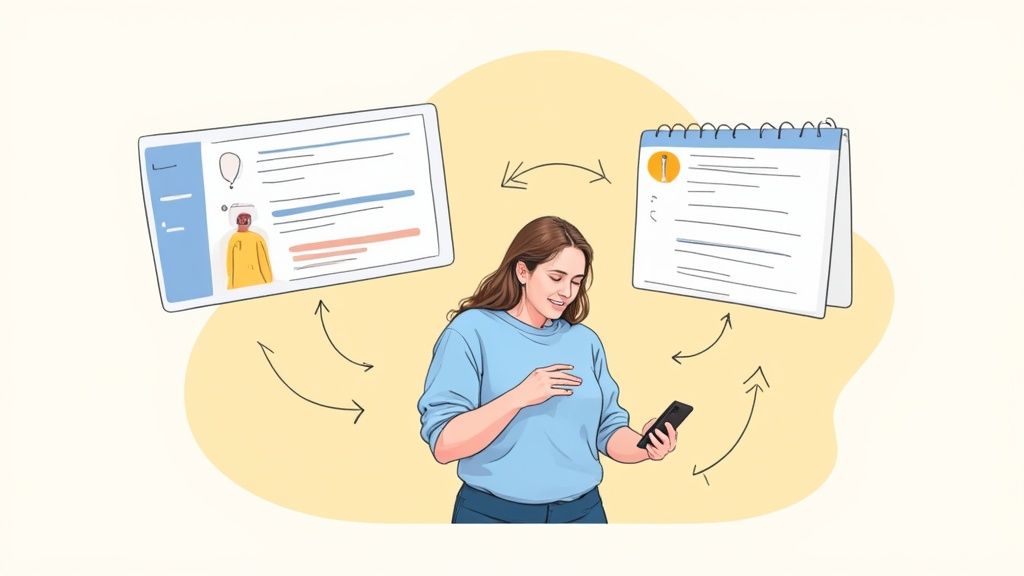
Knowing when and how to follow up can feel like walking a tightrope. It’s easy to get stuck in your own head, but let’s clear up some of the most common questions so you can follow up with confidence.
So, what about sending a second follow-up if the first one goes unanswered? Go for it. Just be sure to give it enough time. After your initial check-in, wait another 5-7 business days before nudging them again. The goal is to show you’re persistent and genuinely interested, not to pester them.
Adjusting Your Message for Each Stage
A one-size-fits-all follow-up just doesn’t work. The note you send after a 15-minute phone screen should be totally different from the one you write after a final round with the entire team. You have to adapt your approach as you get deeper into the process.
- After the Phone Screen: This one is all about speed and clarity. Keep it short, thank them for their time, and quickly restate why you’re a great fit. Your only goal here is to get to the next round.
- After the First Interview: Now you can add a bit more substance. Bring up something specific you discussed—maybe a project or a particular challenge they mentioned—and briefly connect it to your skills or a past success.
- After the Final Interview: This is where you really drive home your enthusiasm. Talk about why you’re excited about the company’s mission or how you felt a real connection with the team. You want them to feel your excitement.
Key takeaway: Specificity is your best friend. A generic “Thanks for the chat” is forgettable. But a line like, “I particularly enjoyed hearing about the team’s new approach to data analytics,” shows you were actively listening and engaged.
And what about LinkedIn? Should you connect? Absolutely. Sending a connection request to the recruiter or hiring manager after you’ve spoken is a smart, professional touch. Just make sure you add a personal note to the request to remind them of your conversation. It’s a low-effort way to stay on their radar.
When you boil it down, a great follow-up strategy is all about being polite, professional, and strategic. Every message is one more chance to prove you’re the right person for the role.
Tired of staring at a blank page, trying to write another cover letter? Jobcamp uses AI to create application documents perfectly tailored to any job you want. We’ve seen it boost interview chances from a typical 8% to as high as 60%. See for yourself at https://www.jobcamp.ai.

